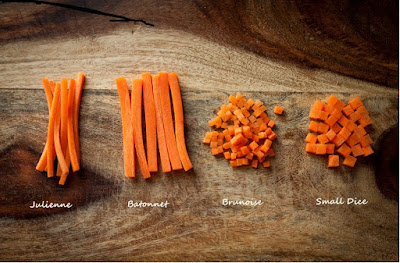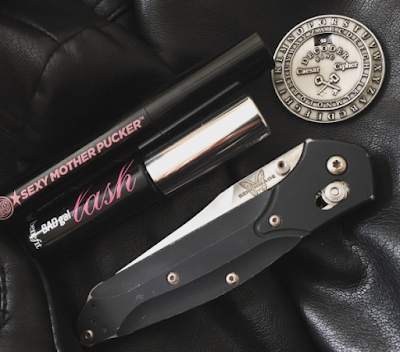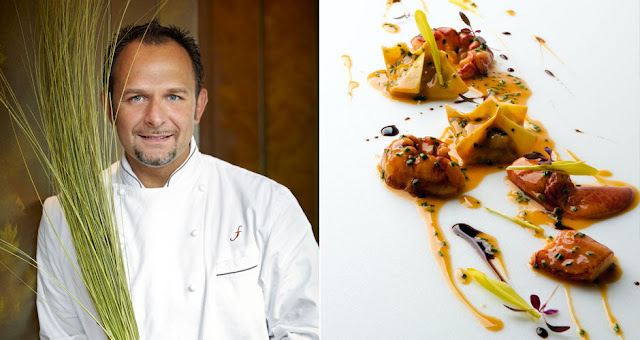By Sonja Stone
It’s no coincidence that the acronym for the Culinary Institute of America is CIA.
It turns out, culinary skills are terribly useful both inside and outside the kitchen. I attended Le Cordon Bleu, and many of the lessons I learned are equally applicable to espionage.
The Five-Second Rule
If we’re going to be friends, you need to know something about me. I do not maintain a level of cleanliness in which it is ever safe to eat food off the floor, five seconds or not.
However, when it comes to my kitchen counters, cutting boards, knives and utensils, I am neurotic about cleanliness. I clean with antibacterial soap, vinegar and hydrogen peroxide—and never a sponge. So if you eat something I’ve prepared and become deathly ill as a result, know that the poisoning was intentional.
FIVE KITCHEN RULES EVERY SPY SHOULD FOLLOW:
1) Knife Skills: Learn it, Live it, Love it.
 |
| Culinary Knife Cuts |
Just as a chef must know the difference between brunoise and tourne, battonet and julienne, so a spy must know the difference between slicing, jabbing, and stabbing.
I always carry a knife. Always. It’s not a defensive weapon, it’s a functional instrument. I carry a Benchmade Osborne with a serrated blade and AXIS-assist opening mechanism. I’ve carried this knife every day for the last decade. You’d be surprised how often I use it.
People constantly ask me (usually when they find themselves in need of a knife—which I am able to provide), “Why are you carrying a knife?”
The obvious answer, of course, is, “For this.” (Whatever “this” happens to be.) But the better question is, “Why aren’t you?”
I believe everyone should always carry a knife, but I also believe it’s a lousy choice for a weapon. For starters, you have to be really close to your attacker to use it. Secondly, it’s fairly easy to disarm someone if one knows what one is doing, which puts you at risk of losing your knife. And using throwing knives as a weapon is kind of just arming your opponent.
But as a spy, you need to carry a knife. Get a teflon-coated blade so it won’t glint in the moonlight. The last time I used my knife in an emergency was when I locked myself out of a place I was temporarily staying. The garage door failed to open more than four inches and I didn’t have a key. I’d left my bedroom window open, but the screens were bolted in place. So I used the back of my Benchmade blade as a screwdriver, removed the screen, and climbed in without damaging the property.
If you absolutely must defend yourself with a knife (and hey, any port in a storm), please don’t attempt the overhead stabbing motion made famous in Psycho. Anyone with any defensive training whatsoever should be able to block that strike. Instead, hold the knife as though you’re chopping peppers, and make quick, decisive jabs into your opponent; the more the better. The goal here is to cause blood loss. Getting close enough to drive the knife into his gut puts you in danger of getting your butt kicked, so don’t do it.
2) Mise-en-place: Everything in its Place.
Unpreparedness in the kitchen is unacceptable. If my fresh herb garnish and finishing sauce aren’t ready when the fish comes off the fire, my guests are presented with a dry, rubbery entree.
I would rather them starve.
The same mise-en-place lifestyle holds true for spies: Fortuna est paratum (fortune favors the prepared). Your go-bag better be packed and ready. Knives sharpened, night-vision goggles polished, 9mm cleaned and oiled with three full mags. Let’s not leave to chance that you can find your surveillance gear on the way out the door.
(For more on mise-en-place as a lifestyle, check out this fantastic article from NPR: http://bit.ly/living-mise-en-place.)
3) Respect the Hierarchy: Do Your Effing Job.
There is one appropriate answer to any request made by the head chef: “Yes, Chef.”
Before 1900, Chef Auguste Escoffier created a kitchen brigade system which is still widely used today. The system carefully assigns roles and streamlines the functioning of a kitchen. The saucier should not be performing the tasks assigned to the grillardin. The garde manger prepares the salads; he shouldn’t be near the station of the patisserie.
Likewise, if I’m an intelligence analyst, I’ve no business on the rooftop with a sniper’s rifle trained on the prime minister. Anarchy ensues. Soldiers are taught to protect in this order: the mission, the men, and me.
First and foremost, do your job. And do it well.
4) The Devil is in the Details.
I took a cooking class from Chef Fabio Trabocchi, formerly of Maestro’s at the Ritz-Carlton in Tyson’s Corner, Virginia. He presented us with recipes; the ingredients were listed in grams rather than ounces. He’s Italian, so no one was shocked, but he explained that it wasn’t his European upbringing that prompted his use of the metric system. He’d noticed that (American) cooks felt fairly confident they could ‘eyeball’ two ounces of flour, a teaspoon of sugar, an eighth of a teaspoon salt. Chef Trabocchi, as perfectionist a chef as I’ve ever met, didn’t want his carefully crafted recipes ‘eyeballed.’
The details matter for spies, as well. One afternoon at the gun range I learned that the (case of) ammunition I’d just purchased consistently jammed my gun. Like, every third shot. Let me tell you, if I have to stop and clear my weapon every three trigger-pulls, I’d rather find out at the range than out in the woods as a bear rifles through my pack for the aforementioned Italian delicacies.
5) Wine is for Cooking: Keep Your Wits About You.
So by now you’ve realized Julia Child wasn’t the only spy-chef among us. Julia was fond of saying, “I enjoy cooking with wine, sometimes I even put it in the food…”
Might I suggest, for those of you who don’t have the alcohol tolerance of Fleming’s spy, that you refrain from the James Bond martinis until after your mission is complete? And remember:
Don’t recklessly pour wine into a saute pan on a gas range.
Don’t trust the cocktail waitress plying you with gimlets.
Don’t think for one second that vodka is odorless. We can still smell you.
Recipe of the Day:
My blog sisters have posted a sophisticated selection of cocktails in the last few weeks. Since I write for young adults, I’ll offer a mocktail recipe, complete with local flavor from the Sonoran Desert (where I live).
If you’re over 21, feel free to spike the drink with a shot of tequila. (Personally, I’d go with Herradura). And omit the prickly pear syrup. And ginger beer. And ice. Herradura in a tall glass.
 |
| Prickly Pear Ginger Beer Mocktail |
PRICKLY PEAR GINGER BEER MOCKTAIL
Serves 2 (because 3’s a crowd)
Ingredients:
2 bottles of ginger beer, chilled
2 tablespoons prickly pear syrup, room temperature
2 tall glasses full of ice
Directions:
Pour a tablespoon of prickly pear syrup into each glass. Top with ginger beer, garnish with a spring of mint, a lime wedge, or an edible flower. Serve and enjoy!
Killer Cocktail: To make fatal, garnish with a sprig of oleander.*
*This is a joke. Please do not do this. Seriously.
Photo credits:


















































That mocktail recipe sounds delicious! I'm wondering about the fruit in the glass. Is that sliced prickly pear fruit?
Ok, the knife stuff is great. I carry a very small, very sharp pocket knife that I picked up in Beaune, France on the theory that one of my characters would carry something similar. I love the recipe for the cocktail, by the way. Love most things with ginger beer.
I want you to have my back, Sonja. My god, knives & poison! Not only are you a fantastic novelist, you kill & cook!
Rachel, the fruit in the glass is indeed prickly pear! The photo is from thegirlonbloor.com. Prickly pear fruit isn't currently in season, but when it is, it's readily available. But if you want to try it right off the plant, you will have to fight birds and javelina.
S. Lee, isn't it handy? I'm so used to wearing a knife that I have to set an alarm on my phone to remind me to remove it before traveling.
Gayle, I absolutely have your back! You gather the intelligence and I'll execute the mission. 😉
Attending Le Cordon Bleu? Who knew? OK, now whenever we all get together, you are not only tasked with cooking dinner but showing those of us who have not had "survivor training" exactly how it's done. You are amazing — and so was your post! Thanks, Sonja!
Thanks, Karna! I'd be delighted to cook for you! I must confess, however, that I am a TERRIBLE teacher. I can demonstrate but that's about it. My idea of teaching is saying the same exact thing over and over at increasing decibels.
You don't have to teach me a thing. I'm happy to just eat.
Notice, by the way, that your cooking class in Tysons Corner was only a few miles from the Agency. The other reason that chef was using metrics.
Francine, I'll cook in exchange for lessons from YOU, our resident spy!
Love this post. You did a brilliant job tying food to spying with so many parallels. I wish we could sit down and enjoy a cocktail together.
Thanks, KJ! We should plan on that! Summers in Canada and winters here in Arizona!
I enjoyed your post Sonja! Humorous, creative, and informative. The perfect ingredients.
Thank you, Sylvia! I'm so glad you enjoyed it!
Made me think of stories Danielle (one of my daughter's) told about studying at the Cordon Blue one summer–especially the bit about the knives. Loved the post.
Christine, your daughter also attended? How fantastic! Knife skills are life skills!